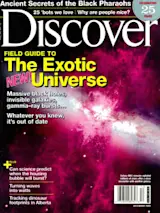As any science-savvy sixth grader can tell you, looking at the stars means looking at the past. Light from more distant parts of the universe takes longer to get here—billions of years in some cases—and therefore, as telescopes become more powerful, astronomers can see farther and farther back in time.
The roots of this idea date back to the 17th century, but only recently have we understood the full relationship between light and history. A century ago this year, Albert Einstein showed that the speed of light is not just finite but also constant and absolute. In the emptiness of space, light travels at a rock-solid 186,282 miles per second, and nothing can travel faster. In other words, a beam of light from a more distant star can never overtake one from a closer star. The universe's stories never fall out of order.
December nights are particularly good times to ...














